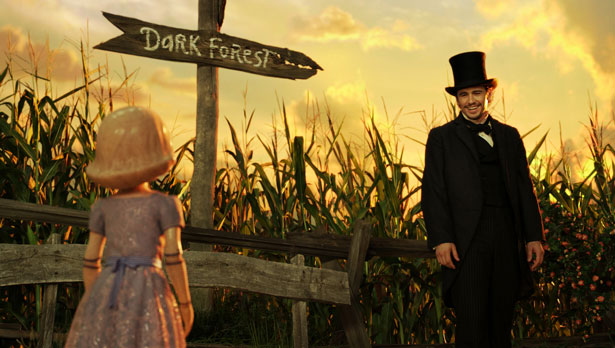
James Franco in a scene from Oz the Great and Powerful. (AP Photo/Disney Enterprises)
Glenn Kenny, a film critic friend of mine, notes at MSN Movies that the problem with this new Oz the Great and Powerful is that James Franco is grievously miscast as the Wizard of Oz. To me this was more or less clear from the trailer, Franco’s bumble-stoner presence an instant false note when placed in the same frame as the self-possession of Mila Kunis, Michelle Williams and Rachel Weisz. (I haven’t seen the movie yet.) But the disparity of talent there only mirrors the way the Oz story has been structured, from the moment L. Frank Baum set pen to paper. As underscored by spin-off work like Wicked, the fact is, Oz has always been matriarchal. Which is not, in this case at least, a feminist utopia in the sense of being a place where women nurture each other right into Scandinavian social-democratic bliss. Instead, in Oz, as Alison Lurie once put it in The New York Review of Books, “Women rule all the good societies and some of the bad ones.” For every Glinda, you get a Wicked Witch.
There is, of course, other proof of women’s power in Oz than the rule of the witches. Dorothy’s male companions, literary scholars point out, are all robots and scarecrows and stuffed antelope heads. The Wizard himself is a disappointment. Ozma, the rightful ruler of Oz, is at one point a boy, but it turns out to be a spell disguising her true gender. What’s more, on some level the books were self-conscious about their denigration of men. At the end of the original book, The Wonderful Wizard of Oz, the denizens of the Emerald City remark that “there is not another city in all the world that is ruled by a stuffed man.” But the narrator observes, “And so far as they knew, they were quite right”—implying that not all stuffing is visible on the outside, if you catch his drift.
Given that these are all early-century books, the progressiveness of it might seem remarkable, but then Frank Baum was unusually well-connected to one of the more radical figures in early American feminism. He’d married a woman named Maud Gage, whose mother, Matilda Joslyn Gage, was a feminist who worked alongside Susan B. Anthony and Elizabeth Cady Stanton. But Matilda Gage was more than a simple suffragette or birth control activist; she was a philosopher and a theosophist as well as a historian. She believed in reincarnation, and developed an entire theory that “man” had suppressed traces of an earlier history of matriarchy, particularly among First Nations people:
Popular
"swipe left below to view more authors"Swipe →
These records prove that women had acquired great liberty under the old civilizations. A form of society existed at an early age known as the Matriarchate or Mother-rule. Under the Matriarchate, except as son and inferior, man was not recognized in either of these great institutions, family, state or church. A father and husband as such, had no place either in the social, political or religious scheme; woman was ruler in each.
She also wrote extensively on Christian theology and its role in the oppression of women. In particular, she was obsessed with witches and witchcraft, whose demonization she saw as irrational and devaluing of women long before 1990s-style Wiccans took up the call of recharacterizing witches as “wise women”:
Whatever the pretext made for witchcraft persecution we have abundant proof that the so-called “witch” was among the most profoundly scientific persons of the age. The church, having forbidden its offices and all external methods of knowledge to woman, was profoundly stirred with indignation at her having, through her own wisdom, penetrated into some of the most deeply subtle secrets of nature: and it was a subject of debate during the middle ages if learning for woman was not an additional capacity for evil, as owing to her, knowledge had first been introduced in the world.
Biographers of Baum routinely declare that he borrowed the concept of the Good Witch wholesale from Gage’s writings, though none cite any particular admission by him that he consciously did so. But Gage certainly encouraged her son-in-law to publish the stories he told his children, a piece of advice she did not live to see carried out. She would die in 1897, three years before the publication of the first of the Oz books. So she never got to see how he ended up popularizing her ideas for generation upon generation of American children.
The good and bad witches of Oz, delicious campy parts though they might make for Hollywood actresses, are hardly role models, mind you. There are few American girls who looked forward to growing up as Glinda, much less the Wicked Witch of the West. But these character did, in some sense, open the options, ones we still struggle with over here in “Kansas” today, in that they got to rule whether or not they were perfectly good or perfectly bad. They did not have to conform to the kind of “likability” we demand of modern female leaders, because of their otherworldliness, perhaps. But having etched into your childhood some idea that women, too, could exercise raw power—it had, I think, to be worth something.
Despite years of protest, Katha Pollitt writes, Saudi women still can’t drive.


